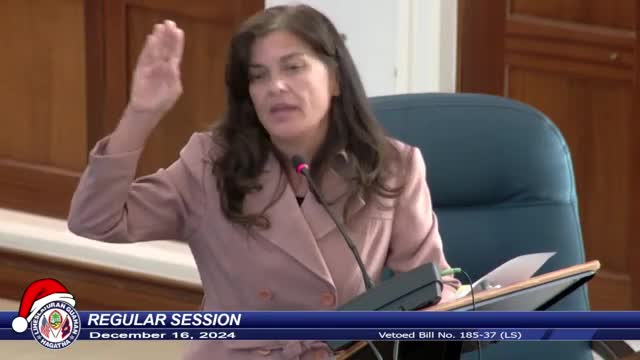Senators demand transparency as hospital funding issues escalate in Guam
January 01, 2025 | General Government Operations and Appropriations , Legislative, Guam
This article was created by AI summarizing key points discussed. AI makes mistakes, so for full details and context, please refer to the video of the full meeting. Please report any errors so we can fix them. Report an error »

The Guam Legislature is facing significant challenges in advancing plans for a new hospital, as discussions during the 37th Regular Session on December 16, 2024, revealed deep divisions between lawmakers and the governor's office. A key point of contention is the proposed location and funding for the hospital, with legislators expressing frustration over a perceived lack of transparency and communication from the governor regarding the project.
During the session, lawmakers highlighted that infrastructure costs for the new hospital would be significantly lower than previously estimated, with suggestions that the project could be expedited if proper details were shared. Concerns were raised about the governor's alleged agreements with military officials that could hinder the declaration of excess lands, which are crucial for the hospital's development. Legislators emphasized the need for clarity on how American Rescue Plan (ARP) funds would be utilized, particularly in light of a projected $1 billion cost for the new facility.
The urgency of the situation was underscored by references to the current healthcare crisis on the island, with calls for immediate action to address the lack of resources and facilities, especially in southern Guam. Lawmakers pointed out that community health centers in the area have been underfunded and are not meeting the urgent care needs of residents.
Support for the proposed hospital site at Epau Point was reiterated, with multiple medical professionals and organizations voicing their backing for the location based on its accessibility for emergency services. Legislators argued that the current administration has not made sufficient progress on healthcare improvements over the past six years, and they urged the governor to engage more openly with the legislature to facilitate the project.
As discussions continue, the legislature is poised to take a more active role in shaping the future of Guam's healthcare infrastructure. The outcome of these deliberations will be critical in determining how effectively the island can respond to its pressing medical needs and ensure that the voices of its residents are heard in the decision-making process.
During the session, lawmakers highlighted that infrastructure costs for the new hospital would be significantly lower than previously estimated, with suggestions that the project could be expedited if proper details were shared. Concerns were raised about the governor's alleged agreements with military officials that could hinder the declaration of excess lands, which are crucial for the hospital's development. Legislators emphasized the need for clarity on how American Rescue Plan (ARP) funds would be utilized, particularly in light of a projected $1 billion cost for the new facility.
The urgency of the situation was underscored by references to the current healthcare crisis on the island, with calls for immediate action to address the lack of resources and facilities, especially in southern Guam. Lawmakers pointed out that community health centers in the area have been underfunded and are not meeting the urgent care needs of residents.
Support for the proposed hospital site at Epau Point was reiterated, with multiple medical professionals and organizations voicing their backing for the location based on its accessibility for emergency services. Legislators argued that the current administration has not made sufficient progress on healthcare improvements over the past six years, and they urged the governor to engage more openly with the legislature to facilitate the project.
As discussions continue, the legislature is poised to take a more active role in shaping the future of Guam's healthcare infrastructure. The outcome of these deliberations will be critical in determining how effectively the island can respond to its pressing medical needs and ensure that the voices of its residents are heard in the decision-making process.
View full meeting
This article is based on a recent meeting—watch the full video and explore the complete transcript for deeper insights into the discussion.
View full meeting